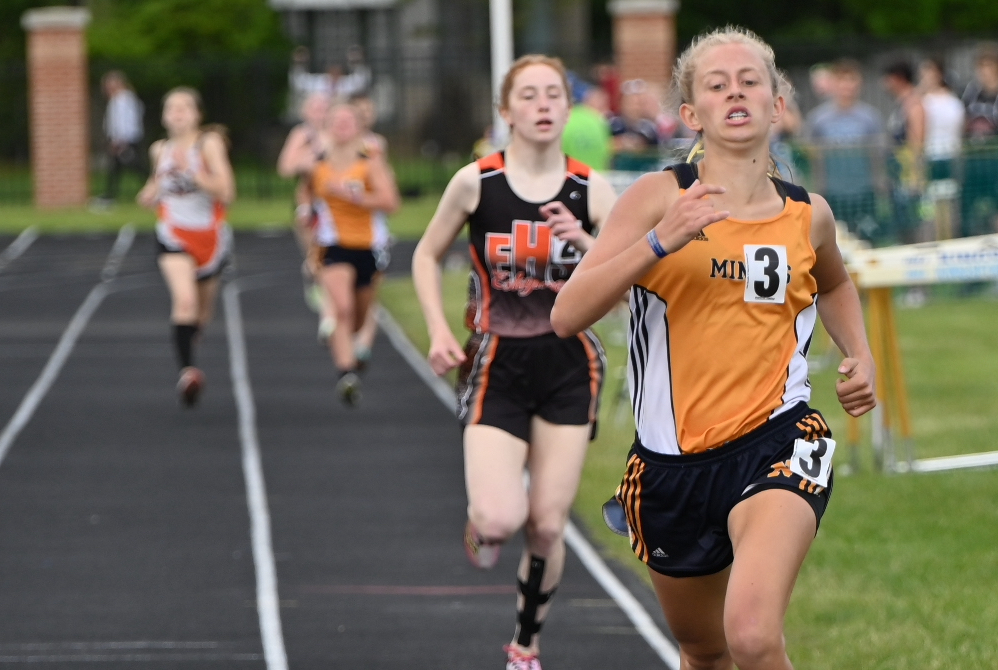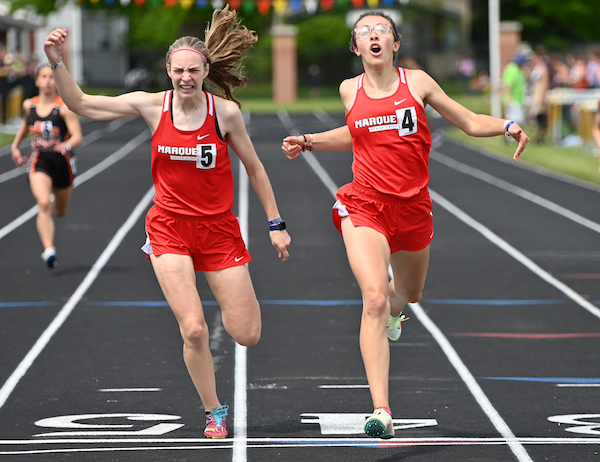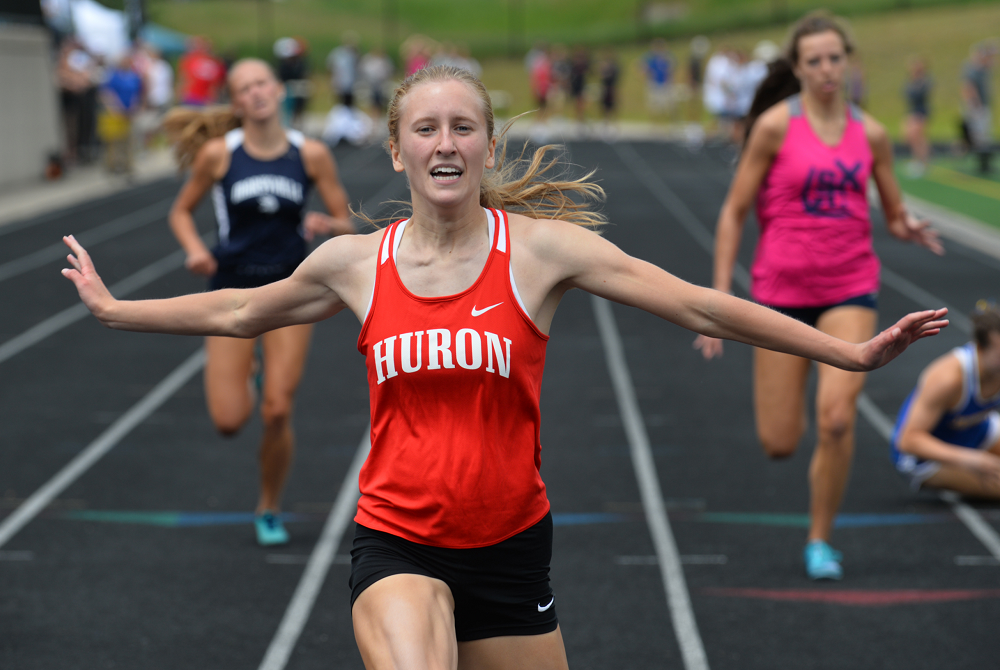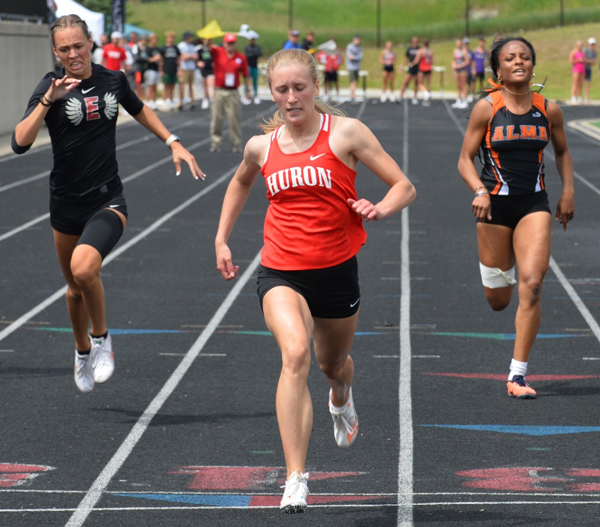
Negaunee Out-Throws, Out-Races Expectations to Reign in UPD1
By
John Vrancic
Special for MHSAA.com
June 5, 2022
KINGSFORD — The Negaunee girls were ranked third coming into the Upper Peninsula Division 1 Track & Field Finals here Saturday.
Apparently, the Miners didn’t pay much attention to that as they captured their first title in four years with 119½ points. They were followed by two-time reigning champion Marquette with 98 and Sault Ste. Marie at 86.
“They outperformed their ranking,” said Negaunee coach Vickie Paupore. “Every single girl stepped up. I’m so proud of their grit and determination. Endla (Harris) was ranked eighth and placed second in the 1,600 (5:43.82) and Madison Pekrul winning the 100 hurdles (17.35) and taking second in the 300s (50.32) is an example of a freshman stepping up. We have good senior leaders, and they got the job done today. I appreciate the effort of all the assistant coaches. They make my job so much easier.”
In the weight events, Negaunee grabbed the top three places in shot put and senior Alyssa Hill, who plans to continue her track & field career at Bemidji (Minn.) State University, won discus at 120 feet.
“I had hoped to throw a little farther in disc,” said Hill, who set the school record at 123-4 in the Regional at Negaunee on May 19. “There was a little bit of wind, and I probably started thinking about it a little too much. I thought I had pretty good technique.
“A lot of girls on our team had PRs (personal records) today. Our 3,200 relay had its best time by about 30 seconds, and Natalie Bell had a PR in shot. We were ranked 1-2-7-8 in shot and got 1-2-3-5. We moved up a little.”
Junior Eliana Juchemich took shot put with a personal-best throw of 36-3¼. Hill was runner-up (32-5½) and Bell took third (31-6½).
 “This is awesome,” she said. “I think my speed was pretty good in the circle, but I had to fix my angle before my release. You want to go with a 45-degree angle. You want to get good enough elevation and yet not too much. If you throw too high, you might not get the distance you want. That was an awesome thing today because everybody wants to win. Our team is real good. We push each other in practice, and it showed today.”
“This is awesome,” she said. “I think my speed was pretty good in the circle, but I had to fix my angle before my release. You want to go with a 45-degree angle. You want to get good enough elevation and yet not too much. If you throw too high, you might not get the distance you want. That was an awesome thing today because everybody wants to win. Our team is real good. We push each other in practice, and it showed today.”
Aubrey Johnson provided Negaunee with an additional first in the 800-meter run (2:30.44).
Marquette showed its speed with Beax Truckey and Julia Ott placing 1-2 in the 100 and 200.
Truckey took the 100 (12.98) and 200 (26.51) and Ott was clocked at 13.01 and 26.59, respectively. The Redettes also captured the 400 (51.99) and 800 relays (1:48.37).
Sault Ste. Marie’s Claire Erickson won the 300 hurdles (49.55) and Cassandra Gallagher took the 3,200 (12:36.83).
Houghton senior and Michigan Tech recruit Ingrid Seagren, who led the entire 3,200 until the final home stretch, was runner-up (12:37).
“This is a real heartbreaker,” said Seagren, who helped the Gremlins win the 3,200 relay (10:19.08). “I’m disappointed in my finish.
“(But) we ran a decent time in our relay. I’m proud of our team.”
Escanaba senior Ciara Ostrenga won the 400 in a personal-best 1:00.22 and helped the winning 1,600 relay (4:16.27).
“After we got fourth in the 3,200 relay, I just wanted to work hard and try to leave here with an individual medal,” she said. “I think our relay did pretty good. All the girls worked and tried hard.”
Houghton's Maria Velat competed in the first-time adaptive events in the 100 (26.56), 200 (51.15), 400 (1:35.96) and shot put (10-0).
PHOTOS (Top) Negaunee’s Aubrey Johnson charges toward the finish on the way to winning the 800 on Saturday. (Middle) Marquette’s Julia Ott (5) and Baux Truckey (4) have a close finish in the 200, with Truckey edging her teammate by eight hundredths of a second. (Click for more from Cara Kamps/Run Michigan.)

Multi-Sprint Champ Racing to Finish Huron Career Ahead of the Rest Again
By
Keith Dunlap
Special for MHSAA.com
May 25, 2023
NEW BOSTON – If there was one thing Elizabeth Anderson took pride in elementary school, it was simply showing that she could outrun everyone in sight.
 In fact, Anderson has an explanation for all the success she had in those playground races.
In fact, Anderson has an explanation for all the success she had in those playground races.
“Dominance when you are in elementary school,” Anderson quipped. “I don’t think I ever had a nickname. I just think everyone knew I was fast.”
Years later, pretty much everyone who follows track & field in the state of Michigan can attest to that.
A senior for New Boston Huron, Anderson has been faster than most other competitors in the state during her three-year high school career (with her freshman season in 2020 canceled due to COVID-19).
Last year, Anderson won titles at the Lower Peninsula Division 2 Finals in the 200-meter (25.07) and 400-meter (56.28) dashes, and was runner-up in the 100-meter dash (12.23).
Often, top sprinters focus on one or two of those three races. But Anderson is certainly a different breed of sprinter because she does all three.
In fact, she holds school records in all three of those events, and if all that weren’t enough, Anderson is a part of all three sprint relay teams.
“It is hard to give her events off,” said New Boston Huron head girls track coach Danielle Lobato.
Despite the different styles the 100, 200 and 400-meter dashes present, Anderson said there usually isn’t much adjusting when she goes from one of those races to another.
 The strategy is simply, “Let’s beat the other girls to the finish line.”
The strategy is simply, “Let’s beat the other girls to the finish line.”
“I don’t really go into each race changing up how I would run,” she said.
While enjoying and succeeding in all three races, Anderson said she actually does have a favorite among them.
“I would say the 400 is probably my favorite,” she said. “Even though it hurts, it’s satisfying to see how much you can get your time down in the 400 compared to any other race.”
Anderson said she started running track in sixth grade, but really got serious about it during the summer after her sophomore season, when she was invited to run for a local club.
Eventually, that led to her competing over the winter in indoor events.
She lived and breathed track so much that last fall, she decided to not run cross country so she could focus on a weightlifting regimen aimed at developing more leg strength.
“Once I started doing summer track, I realized I wanted to be doing this all the time,” she said.
Lobato said oftentimes in practice, Anderson is a de facto coach, given there is no better person she can think of for the younger runners on the team to learn from.
“I can’t always demonstrate these things I’m trying to teach,” she said. “You get to see it in real life (from Anderson), not in a YouTube video.”
After winning the 100, 200 and 400-meter dashes at her Regional meet last week, Anderson has her sights set on achieving the same trifecta of titles at next Saturday’s Finals in Grand Rapids.
Anderson has signed to run track at Michigan State, but has been plenty motivated to keep producing this spring in her final high school season.
“I’m really looking to defend my titles,” she said. “That is what is really motivating me to keep going. I want to keep in shape for the college season. I don’t want to lose any of the progress I have made. Ultimately, I just love running track.”
And since elementary school, Anderson has loved — and succeeded in — outrunning everyone else to the finish line.
“We knew we were getting something special,” Lobato said of when Anderson arrived in high school. “But you never expect this. All that she has accomplished is amazing.”
 Keith Dunlap has served in Detroit-area sports media for more than two decades, including as a sportswriter at the Oakland Press from 2001-16 primarily covering high school sports but also college and professional teams. His bylines also have appeared in USA Today, the Washington Post, the Detroit Free Press, the Houston Chronicle and the Boston Globe. He served as the administrator for the Oakland Activities Association’s website from 2017-2020. Contact him at [email protected] with story ideas for Oakland, Macomb and Wayne counties
Keith Dunlap has served in Detroit-area sports media for more than two decades, including as a sportswriter at the Oakland Press from 2001-16 primarily covering high school sports but also college and professional teams. His bylines also have appeared in USA Today, the Washington Post, the Detroit Free Press, the Houston Chronicle and the Boston Globe. He served as the administrator for the Oakland Activities Association’s website from 2017-2020. Contact him at [email protected] with story ideas for Oakland, Macomb and Wayne counties
PHOTOS (Top) New Boston Huron's Elizabeth Anderson clears the finish line during last season's LPD2 400 race. (Middle) Anderson, middle, outpaces the field to also win the 200. (Click for more from RunMichigan.com.)

